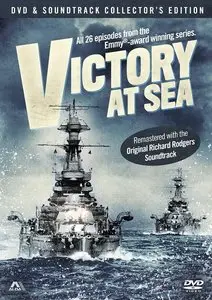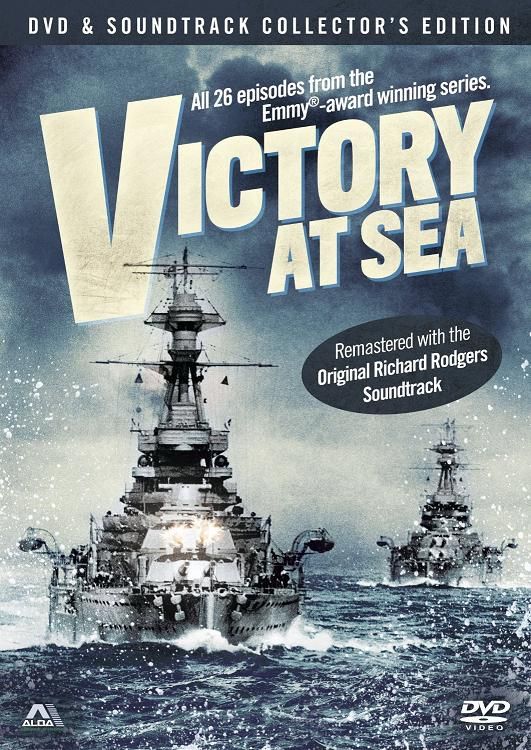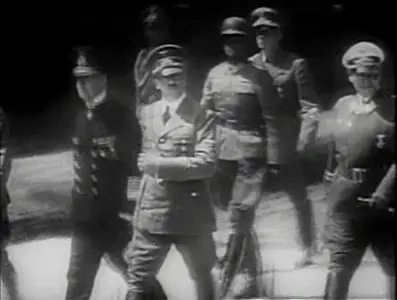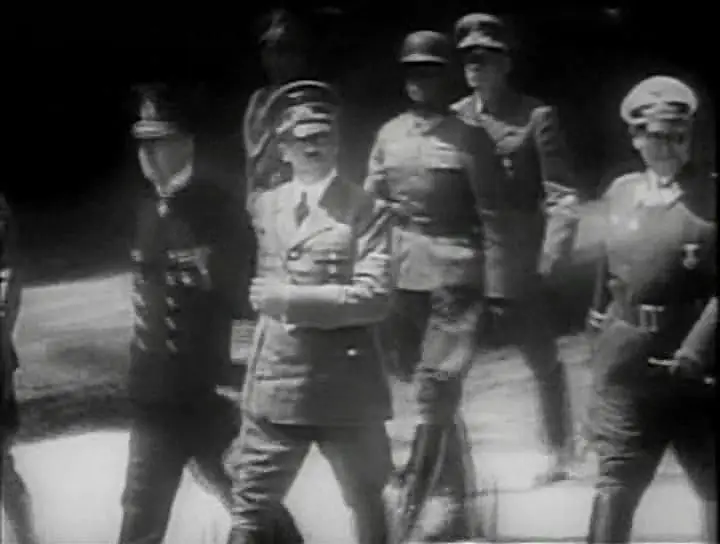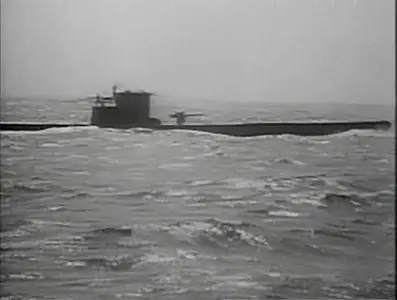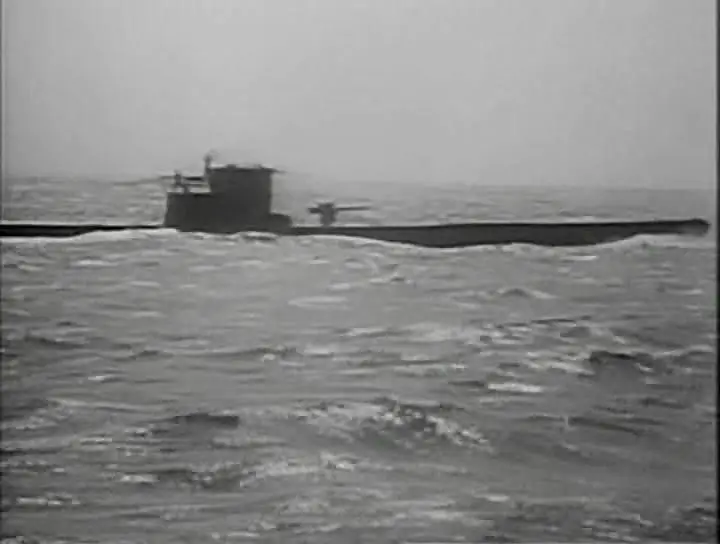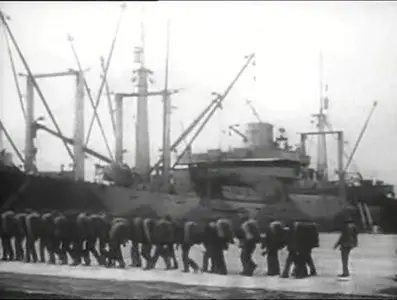NBC - Victory At Sea (1954)
DVDRip | English | AVI/XVID 25.000 fps 1032 Kbps | 720x544 | AC3 192 Kbps 48.0 khz | 26x27mn | 26x232 MB
Genre: Documentary
DVDRip | English | AVI/XVID 25.000 fps 1032 Kbps | 720x544 | AC3 192 Kbps 48.0 khz | 26x27mn | 26x232 MB
Genre: Documentary
The 26 episodes were culled from over 13,000 hours of footage shot by the U.S., British, German and Japanese navies during World War II. Narrated by Leonard Graves and set to a score by Richard Rodgers, this program offered a remarkable look at the realities of naval warfare and the extraordinary challenges faced by the Allies. From U-boat "wolf packs" to the epic battles at Iwo Jima and Okinawa, every major naval engagement of World War II is captured in some of the most riveting combat footage ever shot.
Part 1: Design for War
World War II begins and the Germans succeed in invading Poland and France. But German forces are restrained by the British thanks to the vital convoys, Canadian and American naval forces' initial involvement and the Lend-Lease program. Still, the German submarine war increases its crescendo thanks to new French bases.
Part 2: The Pacific Boils Over
Using Japanese footage, viewers see the planning, execution and, ultimately, the celebration of the country's attack on Pearl Harbor. There also is an explanation provided for the attack and some peaceful moments depicted among the U.S. sailors before the fateful events unfold. Though damaged, the U.S. Navy survives to fight again.
Part 3: Sealing the Breach
With war now declared by the U.S., naval forces throughout the states have joined to bring convoys of supplies across the Atlantic Ocean to the Allies in England. German U-Boats come through and manage to destroy some of ships along the way. Still, the Americans are resilient.
Part 4: Midway is East
The Japanese are ascendant as they successfully invade the East Indies, Singapore and the Philippines. But the Americans are victorious, first on the Coral Sea and ultimately on Midway as they manage to bomb and sink four of Japan's aircraft carriers—the same ones that were used for the attack on Pearl Harbor—making the imperial fleet retreat and giving the U.S. an incredible early victory in the Pacific.
Part 5: Mediterranean Mosaic
World War II comes to the Mediterranean Sea as Italian, French and British naval forces struggle. British forces have the unenviable position of guarding the sea as they escort convoys from Gibraltar to Malta. Still, they have their relaxing moments, especially the daily mealtimes: Morning cocoa, breakfast, dinner, tea, and supper. Meanwhile, the German Luftwaffe never fails to besiege the island of Malta, but the Maltese remain determined to keep fighting. Their heroism is rewarded when King George VI pays a later visit to the island, reviving their spirits.
Part 6: Guadalcanal
After training in Australia and New Zealand, the U.S. Marines land on Guadalcanal. The U.S. Navy suffers defeats by the Japanese Navy around the island—in an area called Ironbottom Sound. Essential information is conveyed about how some deaths are caused not just by battle but also by malaria that comes from the long stays in the Guadalcanal rain forest. The number of people dying on both sides is especially emphasized here, a remarkable example of endurance. Meanwhile, to the tune of Richard Rodgers' most famous march from the series, America's men and materiel are mobilized against the ultimate struggle that is World War II.
Part 7: Rings Around Rabaul
The Japanese Navy is ascendant in its conquests, of which its main base is on Rabaul in the New Britain Islands. This Victory at Sea episode refers to the U.S. strategy of surrounding and strangling the Japanese base in the autumn of 1943 through invasions of its surrounding islands (Bougainville, Rendova). Praise is given to the "Seabees", who made the airfields operational in a brief time, and to observation planes and radar, which helped the U.S. Navy stop Japanese reinforcements and counterattacks.
Part 8: Mare Nostrum
Mussolini calls the Mediterranean "mare nostrum", or "our sea", and seeks to exploit it. British and Greek military forces, however, defeat the Italians, forcing the Germans to send the Afrika Korps. But it is the sea battles to control the Mediterranean that is the crux. At issue is who controls the Suez Canal in Egypt. Eventually, the Allies triumph, and proceeded to destroy the Germans in the desert.
Part 9: Sea and Sand
The USSR government demands a "second front" as their country struggles against the Germans. The wish is granted as Roosevelt and Churchill in Washington agree on the first invasion of North Africa against General Rommel's forces via Operation Torch, while the Allies also neutralize many of the Axis' Mediterranean supply bases. Eventually, the Germans counterattack, but to no avail.
Part 10: Beneath the Southern Cross
The South Atlantic becomes a front in the overall Battle of the Atlantic, from the pursuit of the German ship Graf Spee to the battle between HMS Devonshire and the German raider Atlantis. The Allies, meanwhile, nurture their relations with South America and gain a vital base in Ascension Island. Despite strong sympathy for the Nazis, the South American nations rally to the Allies' cause, securing vital bases, forces and resources.
Part 11: The Magnetic North
This episode of Victory at Sea explores the battles between the Allies and Germans near the Arctic Circle, and the convoys battling past German-occupied Norway to Russia. Meanwhile, the Japanese invade Alaska unsuccessfully, and the U.S. Navy again is ordered to guard this vital area amidst the harsh climate and vast vistas.
Part 12: The Conquest of Micronesia
The ubiquitous aircraft carriers of the U.S. Navy attack in the Central Pacific Ocean at the Gilbert and Marshall Islands, destroying Japanese installations. But for all of these, there is a price to pay for victory.
Part 13: Melanesian Nightmare
The Allies are victorious in New Guinea as they repel the Japanese. They thus bring the fight through a series of "island-hopping" offensives using a new ship—the slow but vital LST. The price paid is great on both sides, but as Japanese casualties increase in their never-ending losing battle against the Allied onslaught, their homeland only hears news of their victory being broadcast by radio. We see also just how Japan's people are suffering in defeat through a very touching scene of a massive funeral at the conclusion of this segment, providing a balance of how universal grief truly is.
Part 14: Roman Renaissance
While Hitler's Germany begins its decline, Mussolini's Italy falls. Eventually, as Naples and Rome are bombed, the Italians surrender. But there is still a slow ruinous campaign (Salerno, Cassino, and Anzio) until final victory is achieved by the liberation of Roma, where Romans celebrate freedom waving American flags, and the Pope addressing the audience…
Part 15: D Day June 6th 1944
The Allied invasion of Normandy is detailed—from preparation to execution—courtesy of vintage footage from both sides. Its a great victory for the Allies.
Part 16: Killers and the Killed
The U-Boats are ascendant, and their triumphs proclaimed in Germany. But the Allies fight back with new bases in countries bordering the Atlantic Ocean, new antisubmarine techniques and the new escort, or "jeep", carrier. Thus, the eventual neutralization and destruction of the German U-Boat forces is guaranteed.
Part 17: The Turkey Shoot
Guam, a U.S. territory, is invaded by Japanese a few days after Pearl Harbor and remains occupied for two and a half years before the Americans arrive to reclaim Saipan and Guam, and destroy as well the Japanese fleet in a classic "turkey shoot". The Guamanians are thankful as expressed on their smiling faces, making it one of the most inspiring segments of Victory at Sea. Meanwhile, the Americans are preparing the bases in the islands as well as in other areas of the Marianas for the ultimate bomber offensive against Japan.
Part 18: Two If by Sea
Before the Philippines Islands, the United States first attacks Peleliu and Anguar. Through communiques, viewers see the battle.
Part 19: Battle for Leyte Gul
The Japanese fleet is disintegrating, and the Imperial Navy conducts its last major operation in the Philippines. It ends in debacle: The risen battleships of Pearl Harbor avenge the attack in Surigao Strait, the Center Force is defeated in Sibuyan Sea, the jeep carriers and destroyers fend off a stronger Japanese force near Samar and the remaining Japanese aircraft carriers are sunk. This Victory at Sea segment marked the near inevitability that the Japanese would accept defeat and surrender to the Allies.
Part 20: Return of the Allies
Just after the U.S. entered World War II, the Japanese conquered the Commonwealth of the Philippines, an American protectorate, occupying its people. But they still hope, and in January 1945, these were answered as much of the Philippines Islands were liberated and its people cheered the Americans. Their liberation became bloody as they fought their way in Manila, but still they cheered. A touching tribute to the will of the Philippine people to survive as they waited for liberation—and their eventual independence a year later.
Part 21: Full Fathom Five
In this episode of Victory at Sea, viewers see how the U.S. Navy's submarines contributed to the Japanese empire's defeat, sinking thousands of tons of commercial ships. Viewers see footage of ship upon ship destroyed. But a price is paid for those whom the U.S. Navy classifies as "did not return".
Part 22: The Fate of Europe
Sevastopol was liberated and the Allies finally defeat Germany. Viewers also witness the meeting of Roosevelt, Churchill and Stalin for final plans for Germany's surrender and the forming of the United Nations. At the end, Hitler commits suicide, and Nazi flags are torn apart and German military uniforms and hats lie on the ground, discarded. However, compelling footage of German cities in ruins make this one of the most somber episodes of Victory at Sea.
Part 23: Target Suribachi
The United States fought two battles here—the U.S. Marines at Iwo Jima against the Japanese, and the U.S. Navy against the typhoon. During the now-legendary events depicted in this episode, the series reaches the final throes of battle in the Pacific war against the Japanese. And as the scene of the recent Mount Suribachi memorial appears, viewers are once again reminded of the price that comes before true victory can be achieved.
Part 24: The Road to Mandalay
The Japanese invade China in 1936, but the Japanese are not satisfied and they invade Indochina and Thailand, enabling the invasion of Burma. The U.S. and British navies nurture their relations with the Indian Navy as supplies are built for the return. Eventually, it was decided to build a road to link with the Burma Road, and with human and elephant power, they succeeded. Eventually, they "came back to Mandalay", and the first supplies travelled the road to hordes of cheering Chinese.
Part 25: Suicide for Glory
In a last effort at glory, having lost most of their best men in military actions, Japan employs suicide pilots—the Kamikaze—men who willingly crash their planes into ships in order to destroy the American spirit. But the U.S. Navy and Marines are ready for them with their guns, and they fought heroically against the onslaught. And on Okinawa, Americans fight a major battle with the Japanese Army.
Part 26: Design for Peace
The atomic bomb is detonated, and its effects demonstrated at Hiroshima and Nagasaki. With that, the Japanese surrender, and their diplomats and military officials sign the official surrender documents aboard the USS Missouri. The U.S. armed forces come home to signs saying, "Welcome Home" before they are greeted by mothers, wives, children and fellow neighbours. But before the series is ended, there is one last parade to march in their honor.
General
Complete name : Victory.At.Sea.01of26.Design.for.War.avi
Format : AVI
Format/Info : Audio Video Interleave
File size : 233 MiB
Duration : 26mn 28s
Overall bit rate : 1 231 Kbps
Writing application : VirtualDubMod 1.5.4.1 (build 2178/release)
Writing library : VirtualDubMod build 2178/release
Video
ID : 0
Format : MPEG-4 Visual
Format profile : Advanced Simple@L5
Format settings, BVOP : 1
Format settings, QPel : No
Format settings, GMC : No warppoints
Format settings, Matrix : Custom
Codec ID : XVID
Codec ID/Hint : XviD
Duration : 26mn 28s
Bit rate : 1 032 Kbps
Width : 720 pixels
Height : 544 pixels
Display aspect ratio : 4:3
Frame rate : 25.000 fps
Color space : YUV
Chroma subsampling : 4:2:0
Bit depth : 8 bits
Scan type : Progressive
Compression mode : Lossy
Bits/(Pixel*Frame) : 0.105
Stream size : 195 MiB (84%)
Writing library : XviD 1.2.1 (UTC 2008-12-04)
Audio
ID : 1
Format : AC-3
Format/Info : Audio Coding 3
Mode extension : CM (complete main)
Format settings, Endianness : Big
Codec ID : 2000
Duration : 26mn 28s
Bit rate mode : Constant
Bit rate : 192 Kbps
Channel(s) : 2 channels
Channel positions : Front: L R
Sampling rate : 48.0 KHz
Bit depth : 16 bits
Compression mode : Lossy
Stream size : 36.4 MiB (16%)
Alignment : Split accross interleaves
Interleave, duration : 96 ms (2.40 video frames)
Interleave, preload duration : 96 ms
Complete name : Victory.At.Sea.01of26.Design.for.War.avi
Format : AVI
Format/Info : Audio Video Interleave
File size : 233 MiB
Duration : 26mn 28s
Overall bit rate : 1 231 Kbps
Writing application : VirtualDubMod 1.5.4.1 (build 2178/release)
Writing library : VirtualDubMod build 2178/release
Video
ID : 0
Format : MPEG-4 Visual
Format profile : Advanced Simple@L5
Format settings, BVOP : 1
Format settings, QPel : No
Format settings, GMC : No warppoints
Format settings, Matrix : Custom
Codec ID : XVID
Codec ID/Hint : XviD
Duration : 26mn 28s
Bit rate : 1 032 Kbps
Width : 720 pixels
Height : 544 pixels
Display aspect ratio : 4:3
Frame rate : 25.000 fps
Color space : YUV
Chroma subsampling : 4:2:0
Bit depth : 8 bits
Scan type : Progressive
Compression mode : Lossy
Bits/(Pixel*Frame) : 0.105
Stream size : 195 MiB (84%)
Writing library : XviD 1.2.1 (UTC 2008-12-04)
Audio
ID : 1
Format : AC-3
Format/Info : Audio Coding 3
Mode extension : CM (complete main)
Format settings, Endianness : Big
Codec ID : 2000
Duration : 26mn 28s
Bit rate mode : Constant
Bit rate : 192 Kbps
Channel(s) : 2 channels
Channel positions : Front: L R
Sampling rate : 48.0 KHz
Bit depth : 16 bits
Compression mode : Lossy
Stream size : 36.4 MiB (16%)
Alignment : Split accross interleaves
Interleave, duration : 96 ms (2.40 video frames)
Interleave, preload duration : 96 ms
Screenshots


